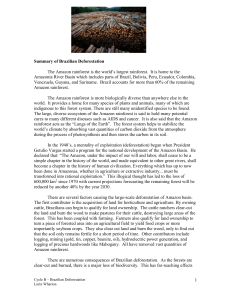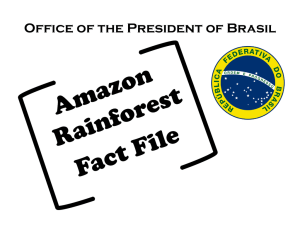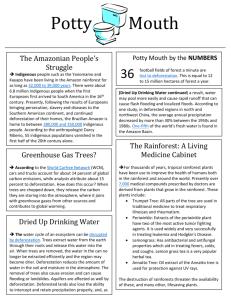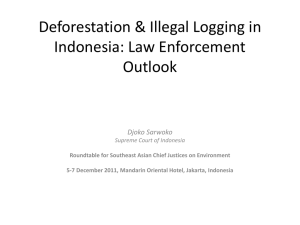Proposta para o debate sobre o Código Florestal
advertisement
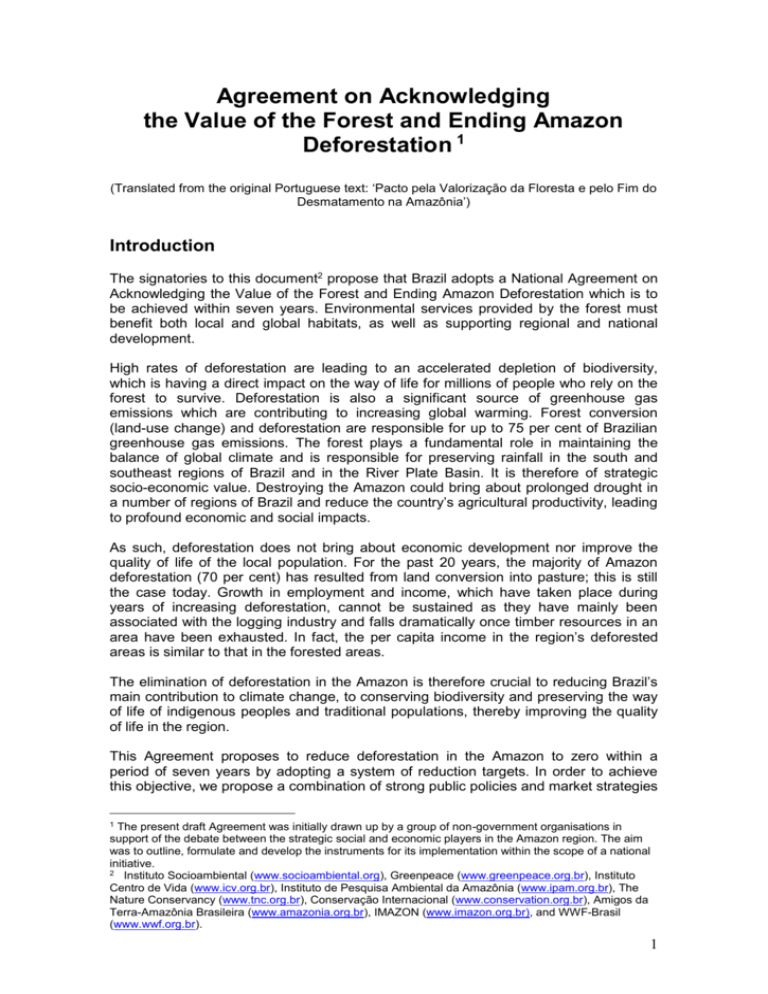
Agreement on Acknowledging the Value of the Forest and Ending Amazon Deforestation 1 (Translated from the original Portuguese text: ‘Pacto pela Valorização da Floresta e pelo Fim do Desmatamento na Amazônia’) Introduction The signatories to this document2 propose that Brazil adopts a National Agreement on Acknowledging the Value of the Forest and Ending Amazon Deforestation which is to be achieved within seven years. Environmental services provided by the forest must benefit both local and global habitats, as well as supporting regional and national development. High rates of deforestation are leading to an accelerated depletion of biodiversity, which is having a direct impact on the way of life for millions of people who rely on the forest to survive. Deforestation is also a significant source of greenhouse gas emissions which are contributing to increasing global warming. Forest conversion (land-use change) and deforestation are responsible for up to 75 per cent of Brazilian greenhouse gas emissions. The forest plays a fundamental role in maintaining the balance of global climate and is responsible for preserving rainfall in the south and southeast regions of Brazil and in the River Plate Basin. It is therefore of strategic socio-economic value. Destroying the Amazon could bring about prolonged drought in a number of regions of Brazil and reduce the country’s agricultural productivity, leading to profound economic and social impacts. As such, deforestation does not bring about economic development nor improve the quality of life of the local population. For the past 20 years, the majority of Amazon deforestation (70 per cent) has resulted from land conversion into pasture; this is still the case today. Growth in employment and income, which have taken place during years of increasing deforestation, cannot be sustained as they have mainly been associated with the logging industry and falls dramatically once timber resources in an area have been exhausted. In fact, the per capita income in the region’s deforested areas is similar to that in the forested areas. The elimination of deforestation in the Amazon is therefore crucial to reducing Brazil’s main contribution to climate change, to conserving biodiversity and preserving the way of life of indigenous peoples and traditional populations, thereby improving the quality of life in the region. This Agreement proposes to reduce deforestation in the Amazon to zero within a period of seven years by adopting a system of reduction targets. In order to achieve this objective, we propose a combination of strong public policies and market strategies 1 The present draft Agreement was initially drawn up by a group of non-government organisations in support of the debate between the strategic social and economic players in the Amazon region. The aim was to outline, formulate and develop the instruments for its implementation within the scope of a national initiative. 2 Instituto Socioambiental (www.socioambiental.org), Greenpeace (www.greenpeace.org.br), Instituto Centro de Vida (www.icv.org.br), Instituto de Pesquisa Ambiental da Amazônia (www.ipam.org.br), The Nature Conservancy (www.tnc.org.br), Conservação Internacional (www.conservation.org.br), Amigos da Terra-Amazônia Brasileira (www.amazonia.org.br), IMAZON (www.imazon.org.br), and WWF-Brasil (www.wwf.org.br). 1 to finance existing forests and their environmental services. It is essential to acknowledge the economic value of forest biodiversity (environmental services, carbon market-related, etc), and also to optimise agricultural use in areas that have already suffered from deforestation. At the same time, it will be crucial to strengthen the forestry management of the States and effective control over illegal deforestation. Economic and technical support must be ensured and directed at government agencies, social players responsible for forest conservation (indigenous peoples, local communities and traditional populations) and producers (forestry companies and farmers) who will adopt strategies to reduce deforestation and improve forest conservation. In this context, one of the main challenges is to guarantee public policies which incorporate the elimination of deforestation within a social, environmental and, for the most part, economic framework. It is necessary to go beyond ‘command and control’ measures by promoting the revision and re-orientation of financial incentives, which historically have been channelled into destructive practices. The technical, economic and institutional details of the Agreement for ending deforestation and acknowledging the value of the forest must be developed in conjunction with the Amazon’s State governments and the Federal government, with representatives of rural and forestry producers and businesses, environmental organisations, social movements, indigenous people and traditional populations of the Amazon. Prerequisites of the Agreement To achieve its objectives, the Agreement is based on the following four prerequisites: 1. Regulatory and economic instruments, which acknowledge the value of existing forests, aimed at the States and other social players (payment for environmental services). 2. Regulatory and economic instruments, which optimise the use of areas that have already suffered deforestation (forest compensation). 3. Strengthening of monitoring, control and tax measures (environmental and landbased). 4. Establishment and strengthening of forestry governance in public land in the region. Support for the Agreement is based on the development of financial remuneration instruments for environmental services provided through forest conservation. These must be aimed at: 1. Strengthening forestry governance through incentives for the States. 2. Establishing economic incentives for social players responsible for forest conservation (indigenous peoples, local communities and traditional populations). 3. Establishing economic incentives for rural producers (private farmers and forestry companies). 2 Deforestation reduction targets The parties to the Agreement are proposing targets to reduce deforestation in the Amazon to zero by 2015 (while allowing continued traditional use of the forest) based on the approximate rate of deforestation verified as being 14,000 square kilometres in the period August 2005-July 2006. The reduction proposed is scaled on an annual basis according to the table below: 7-Year Target Proposals Deforestation (ha) Reduced Deforest. Deforest. 05/06 1,400,000 1st year (25%) 1,050,000 350,000 2nd year (25%) 787,500 612,500 3rd year (30%) 551,250 848,750 4th year (40%) 330,750 1,069,250 5th year (50%) 165,375 1,234,625 6th year (75%) 41,345 1,358,655 7th year (100%) - 1,400,000 3,585,902 6,873,780 Total The percentages are applied on the rate of deforestation verified in the immediate prior year, according to the table above System of reduction targets for the Amazon The proposed system of targets to end deforestation in the Amazon must be based on shared responsibility between the States and the Federal Government so as to be able to clearly define the application of incentives. These targets must follow criteria, which include the relationship between: 1. The territorial extent of each State. 2. The percentage of remaining forest which exists (protected and nonprotected). 3. The effective available area (used and unused). 4. The previous history of deforestation. For granting incentives, the targets should include concrete improvements in management instruments intended to strengthen governance in the Amazon region and provide an inducement to reduce deforestation. These management instruments must be governed by four guiding principles: 3 1. Increase in the percentage of rural properties adhering to rural and environmental licensing systems. 2. Creation and consolidation of Conservation Units (protected areas). 3. Establishment of land settlement methods designed for the Amazon (PAE, PDS and PAF)3 in accordance with their objectives and the implementation of support programmes for indigenous lands. 4. Implementation of a programme of incentives to reduce deforestation. Financial mechanism for environmental services and forest conservation Financial compensation to an Amazonian State for reducing deforestation shall be based on three criteria: 1. Effective reduction of deforestation. 2. Achievement of reduction targets and/or conservation of forests. 3. Satisfactory performance in implementing structural measures for achieving the targets. States which achieve their annual targets for reducing deforestation in a timeframe shorter than that which is stipulated, and do so by implementing the measures contained in this proposal, will receive greater financial compensation than States which fail to meet their target. However, the target may be used as a planning parameter for the measures and the evaluation of results, but its non-fulfilment shall not necessarily exclude the possibility of receiving compensation. Benefits will be suspended only in the case where there is an increase in deforestation. Amazonian Fund for payment of environmental services Investment in the order of R$ 1 billion per year (roughly Euro 390 million) from public and private sources over the seven year period of the agreement has been estimated as being required. This figure is based on a wide range of sources identified in the study “Economic Basis of the Agreement on Acknowledging the Value of the Forest and Ending Amazon Deforestation”, conducted by a group of distinguished economists.4 The economic study investigates two premises: firstly, that Brazil attracts external resources to finance Amazon forest conservation programmes, but 3 PAE-Agroextractive Settlement Project, PDS-Sustainable Development Project, and PAF-Forest Settlement Project. 4 The economic study was developed by Consultoria Macrotempo to subsidize the proposals presented by the signatory organisations. The following economists took part of the group of consultant who developed the document: Amir Khair, Carlos Eduardo Frickmann Young, Luis Afonso Simoens and Vivian Macknight. 4 wishes to maintain its sovereignty over the region. The second premise is that Brazil is ranked as a country of medium income by international financial institutions, which makes it difficult for the country to secure financial resources or donations from these bodies, with the possible exception, of tropical forests. The funding matrix of the present proposal should be largely dependent on public resources. Therefore, Brazilian Federal and Amazon State Governments must demonstrate their commitment to the proposal in order to attract internal resources and additional external funding. The level of economic benefits accruing to States and social actors should be managed by a Donation Fund for Amazon Forest Conservation, or Amazon Governance Fund, which must be related to fulfilling the terms of the Agreement. The economic study also recommends that the Fund should be under the auspices of the BNDES (Brazilian Bank of Economic and Social Development), which is highly respected as an institution both in Brazil and abroad. This would also allow the bank to attract internal resources and catalyse internal and external private funding for the region. The Fund is aimed at: 1. Strengthening forestry management. 2. Payment for environmental services (PSA) orientated towards: • Implementation and management of Conservation Units; • Programmes for socio-environmental development in indigenous lands and the territories of traditional populations; • Programmes supporting sustainable rural development. The study also outlines two further suggestions for investment funds to act as incentives for Amazon forest protection. The three funds proposed by the economists would be established using private and public capital. Private sources would primarily come from external resources (carbon market-related), large national companies and other, mainly institutional, investors. Public funding would come from the general budget of the Federal Government. Projected growth of the Brazilian economy would provide the Federal Government with additional resources which should be directed towards environmental protection. Finally, the study also points to the possibility of Amazon States helping to fund the Agreement. One means of achieving this could be via the creation of a new Federal tax on polluting activities, with the revenue raised being returned to the Amazon States. The Agreement aims for firm commitments by public authorities and the BNDES to in turn attract resources from national and international investors and donors, whether private, official bodies or bilateral government arrangements. It is essential that the proposed structure for managing public resources complies with all relevant legal obligations. With regard to private resources, the proposal allows each State to maintain responsibility for the public management of these 5 resources. The Administration Council of the funds to be set up should be comprised of Brazilian personalities who are well respected in the international environmental field. Final considerations Success in attracting significant investment to put in place a programme to reduce deforestation by providing financial incentives depends on sufficient capacity for planning and evaluation. Equally important is a compensation mechanism for legal reserves 5 to cover liabilities arising in deforested areas as well as to maintain remaining forest assets. It is also essential to develop a reliable method of monitoring whether deforestation is shifting into adjacent regions (known as ‘leakage’) which are not covered by the Agreement, particularly the Cerrado. There is an urgent need for a national debate on permanent, long-term solutions to deforestation in the Amazon. Public interest organisations are relying on the maturity of Brazilian society and the shared interest in ensuring that Brazil is prepared to face up to the global environmental crisis consistent with achieving sustainable development for the country. 5 The legal reserve is the proportion of a landholding that the Brazilian Forest Code stipulates should not be cleared of forest. 6

